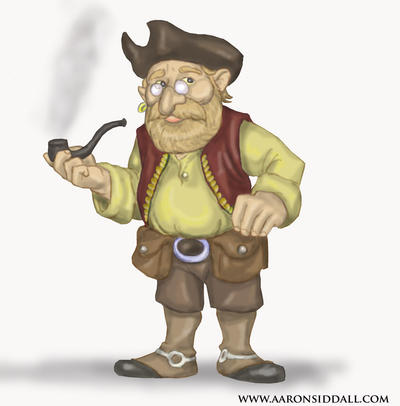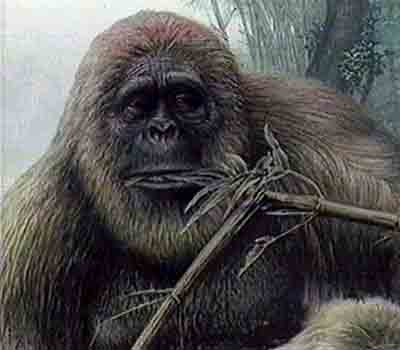The land of Pangea is savage, and haunted by many dangers. Great beasts, wild spirits, and ancient evils all lurk right around the corner. And so the people of this world need to be rugged, versatile but still essentially
human (or human enough). So below are the three primary races of player characters of Pangea. There are other intelligent races, who will be detailed in later posts, but the ones below are the most organized and human friendly in the central campaign region.
Adamu (Humans)
The Adamu are a versatile, and widespread people who can be found in a number of different colors and shapes. In the Middle Lands of Pangea (the beginning campaign region), the Adamu are a predominantly brown-skinned people, with dark-brown to black hair and dark eyes.
Adamu culture is usually based around families, clans and towns and city-states which are ruled by a council of wealthy elders. City States are ruled by ruling families who preside over a council of city fathers. Though laws among clans, towns or nomadic bands are usually simple, those in the city-states are a bureaucratic nightmare, with bribes, corruption and betrayals being common. A wise man steers clear of the law in the city.
The Adamu of Pangea are at the late Bronze Age/Early Iron Age of development. Houses are timber and stone, with nomads using hide tents supported with reed and bone.
In the past hundred years, the rise of the
Church of Heaven has united a number of Adamu clans and city-states under a New Religion. This faith reveres the gods of the sky, the Sun, the Moon (more on this very soon!), The Starry Sky and other luminous lords and ladies. This church, centered in the
Holy City of Meru is the greatest unifier of the Adamu that Pangea has seen in many ages. What the bodes for the future is anyones guess...
Adamu are rolled up as Humans as per the rules in Blood and Treasure pages 3 and 4.
Dakkati (
Neanderthals)
The Dakkati are an ancient people who dwell in the wild mountains and in cold lands. They are renowned hunters, survivors and regarded as nearly magically skilled at working stone, bone and ivory. Dakkati are considered short by Adamu standards, ranging between five and five and a half feet in height, but very stocky and with thick bones.
Dakkati are a softly spoken people with a great love of nature, stories, music (particularly the
bone flute) and family. Hunting, herding, beekeeping and stone-working are major parts of their societies, and so the more nature oriented classes are favored. Druids and storyteller Bards are the central religious leaders and primary spellcasters of the Dakkati. Other, more modern religions and magic users (such as Clerics) are deeply distrusted. Among the Old Gods
Uta the Bear Mother is deeply adored, with Druids and Adepts presiding over services to this "Bear Mother".
Dakkati prefer stone settlements, particularly ones with underground levels. In the mountains, Dakkati will build clan holdings incorporating cave networks and adding on with additional stone and earthworks. Though rough-hewn, these dwelling are always snug and surprisingly comfortable and clean. Most Dakkati prefer stone, bone and horn weapons, though some are starting to trade for metal weapons and tools.
Dakkati modify their starting ability scores as follows: Str +1, Con +1, Cha -1. Dakkati have a knack for survival. Dakkati speak their own unique clan language and might also speak Common, Giant, Terran or Troglodyte. Dakkati may advance in any class, though they prefer nature oriented classes. Dakkati can multi-class as druid/bards, druid/fighters, fighter/magic-users and fighter/ thieves (scout).
Kabiri (
Meganthropus)
The Kabiri are a race of hairy giants who dwell in the hills and mountains. They are kin of the great Giants, though this relationship is strained at best, with only Hill Giants, Ettins and other brutish giant-kin having any sense of kinship with the Kibiri.
When standing fully erect, an adult Kabiri stand from eight to ten feet in height on thick, short legs. Their powerful arms are slightly longer than their legs, this along with their brutish jaws and low brows give them an ape-like appearance.
On their own, Kabiri are a tribal people, having family bands centered around a grand matriarch. These clans live in the harshest wilderness, living in near constant conflict with large predators and harsh conditions. Because of this, Kabiri admire strength and endurance over intelligence.
Magic is greatly feared among the Kabiri, with only the wilder sorts of Druid and Adepts existing as spiritual leaders in their communities, though more often than not such Kabiri mystics live alone. Kabiri worship fierce gods of the wilds such as Oanoe Razorfang, Kuvana Mountain Mother and
Uta the Bear Mother, and have little use for the Church of Heaven.
Kabiri are a stone-age people, stealing, trading or even earning better made equipment and weapons, though they often take some time to learn how to properly tend to such items. As they produce nothing worthy of trade, Kabiri clans often sell their services as mercenaries in return for quality goods, food and a chance to see the wider world.
Kabiri modify their starting ability scores as follows: Str +4 (max. 20), Dex -1, Con +2, Int -2, Cha -2. They are large creatures, so must pay double the normal price for armor. Kabiri have darkvision to a range of 60 feet. They speak Giant, but smart Kabiri often speak Common or other local tongues. Their thick hides give them a +2 bonus to Armor Class. Kabiri can advance as barbarians, druids, fighters, thieves and fighter/druids up to a maximum of 7th level.
















